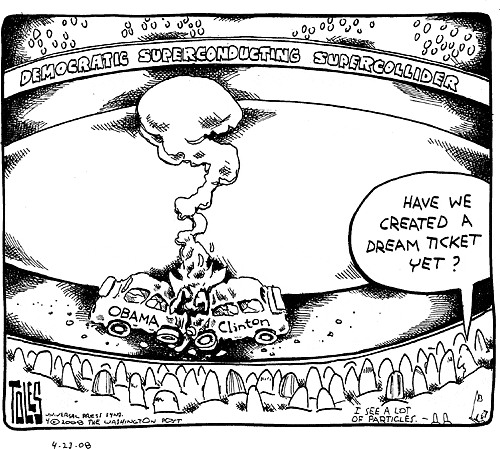When voters went to the polls last year, they cast a vote for change. On many issues, said voters have been disappointed. Unable to seek common ground, our elected representatives have time and time again fallen far short of the will of the People. When I cast my vote, I was looking for candidates who would effect a change in attitude toward science and science policy in Washington, as well as here in California. Optimism is always high in the absence of fact, I suppose. Well, we’ve gone a year with a Democrat-controlled Congress; where does science funding stand?
Let’s look at the progress of the two basic science funding bills. These are the Appropriations Bills for Commerce, Science, (State), and Justice, and for Energy and Water. The former funds the National Science Foundation, the latter the Department of Energy. In FY2007, $3.797 billion was appropriated for DOE Science, and the Senate committee recommended $4.497 billion for FY08. That’s an 18% increase in spending on science, proposed by the Senate. The House, in the same bill, had recommended $4.514 billion, a 19% increase. As usual, the House put up a bit more than the Senate, and we all expected the difference to be worked out in Conference.
When did all this occur? Well, the House and Senate committees finished their work on these bills on June 6 and June 28 of this year, respectively. The House voted on the bill on July 17, but never voted on the bill. Therefore, it never made it to conference, and will (likely) not be on the President’s desk before the Oct. 1 deadline.
What happened in 2006, when the Congress was firmly in Republican hands? Well, the House and Senate committees finished their work on May 17 and June 29 of 2006, respectively. Interestingly, the House was speedier last year, but the Senate took almost the same time (to the day!) as this year. This would imply that Republicans were faster in turning the legislation around for a vote. Let’s look at the increases they proposed, however. Time and money can be inversely proportional, after all.
Last year, the speedier House recommended a 14% increase over FY2006 levels, while the steady Senate recommended an 18% increase over FY2006. Interestingly, the Republican-controlled Senate recommended the same relative increase last year as this year, while this year’s House recommended a higher relative increase than last year’s.
But the end results last year were not encouraging. After four continuing resolutions, which happened because the election intervened, the resulting budgets were increased at about half the recommended levels, not reaching anywhere near these double-digit percent increases. This year, we see the same kind of aggressive proposals for increase, and yet here we are at the deadline. A stop-gap measure will likely be forthcoming, to keep government running. Science sits in the shadows, so much less sexy than a difficult war, jumbled foreign policy, Chinese imports, and even the right of a left-wing liberal lobbying group to put an ad in the NY Times. And yet, a successful basic research program is responsible for the modern foundations of our society, in which blackberries carry last-minute information to staffers about upcoming votes, websites attract donors and gather petitions, and global positioning helps Washington newbies find their way to posh cafes in Georgetown.
Let’s hope that while we all continue to suck the cream out of the pail, we don’t forget to fund the cow. Can either party, separately or together, deliver on the public promise of support for basic research?


